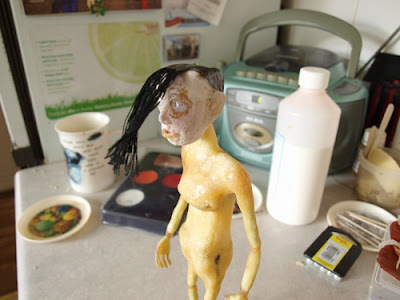That's what I said. It's a
WRAP. And after only a year, that's got to be a record! Actually you can relax, you're nowhere closer to seeing the finished product, this is the end of block ONE and that just means that all the human activity and dialogue is shot. It is also, as the title suggests; processed, printed, synched and chucked into
AVID for a rough cut.
I've been answering a lot of questions about the film recently, I'm even negotiating a first screening date, I feel like a proper little producer this month! It's possible the film's title will change to better reflect the direction which will totally mess up this blog.
So I'm getting used to the ideas behind the film again: what it
is that I'm trying to say. I imagine I'll have to find ways to describe it to people. It's a very simple story. After all, it's three minutes long
and there's only so much that you can say in that time.
Firebird basically describes the moment of turnaround between spiraling despair and hope. It's coming up on the year since I started working on this and that is not lost on me. Of course it's been a terrible season (In case you came in late, I'll again mention that
winter is not for me) but I've got through it by ignoring and hoping it will go away - that seems to be working. See? It's February already! In any case I now have the advantage of lucidity and precious distance to critically view my own behavior and decisions in that other time when things were at their worst. I needn't bore you with the details but while it would be unfair to say that those situations were not bad, my instinctive reactions to them did not help me and they certainly hurt others.
 |
| Bad Hair Day |
That's the state the central character is in, absorbed in fighting for her own sense of existence, she has ignored how important that existence is to the other people in her life. The Firebird forces her to look outside of herself.
Block TWO, meanwhile, is well underway. All the stuff that the bird actually does. It's about six shots and it plays the
counterpoint narrative. No dialogue does make it shoot
faster. I have to say, latex and wire are not the most dextrous of
materials for lip movement, but they have a tenacity and have given me some pleasant surprises.
It's down to the rigging of the face, right? I've learned some valuable - and expensive - lessons about
puppet fabrication. Latex skin is surprisingly tough and takes a lot of pushing to get the wire supporting it to move. When it does move, the most interesting things happen. Unlike clay which lets you move bits independently, stick bits on and shave bits off, latex just tugs frantically at other areas of the face - eye lids, nostrils etc, really anywhere that there is space to give. The resulting expressions are more diverse and imaginative than I could ever control. These little characters really do take on a life of their own and that's why they've taken quite as long to animate as they have.
Animating hair is a story all it's own.
 The film has been selected for screening by Kino London #51 on the first night at their new venue; The Electrowerks club in Angel Islington at 8.15pm on the 13th June. Tickets are £4.00 on the door. Don't worry, there are other films too, I'm not trying to recover the costs in one night!
The film has been selected for screening by Kino London #51 on the first night at their new venue; The Electrowerks club in Angel Islington at 8.15pm on the 13th June. Tickets are £4.00 on the door. Don't worry, there are other films too, I'm not trying to recover the costs in one night! 









